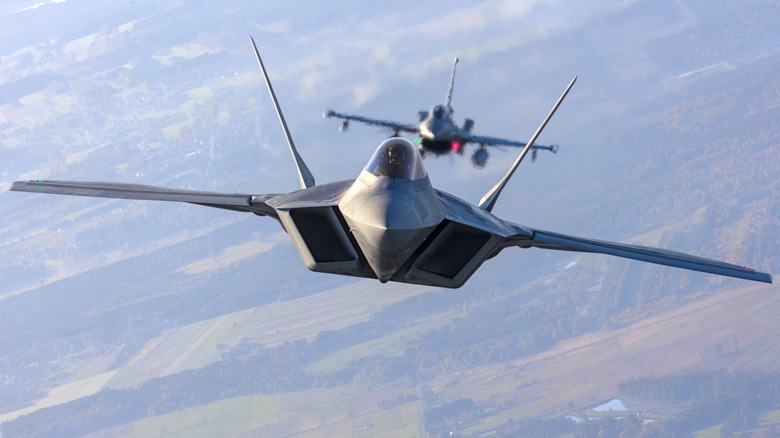
Joris van Boven/Shutterstock
Although early aircraft may not have been all that imposing, the development of the modern fighter jet has led to the creation of truly terrifying machines. The most advanced jets can cause a huge amount of devastation, move at supersonic speeds, and hit targets without even being detected by radar. The Cold War pushed European nations, the Soviet Union, and the U.S. to develop ever more powerful and advanced jets in an attempt to gain an advantage and protect their airspaces.
This has led to a wide range of different fighters being designed and manufactured over the last few decades. Many of them have unique shapes to try and avoid radar and make them more maneuverable, while others are armed with an array of imposing weapons. In either case, this can make these fighter jets look fearsome to anyone who gets a chance to see them — especially enemy forces that might have to face them in combat.
F-16I Soufa
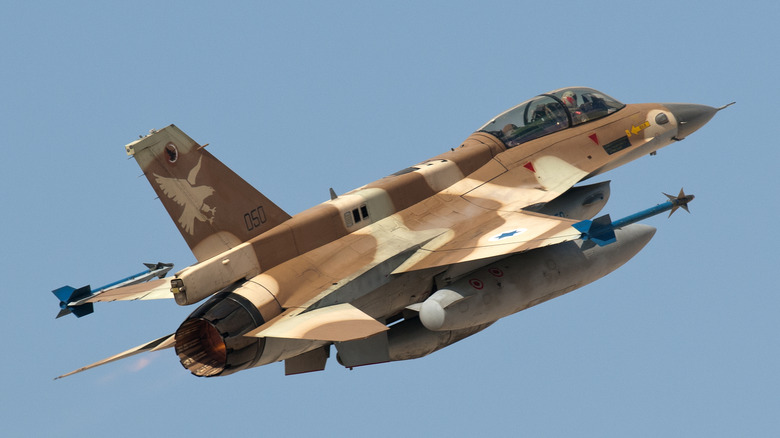
Peter R Foster IDMA/Shutterstock
The General Dynamics F-16 Fighting Falcon is a multirole fighter jet that has been in service since the late 1970s. Although the F-16 has a number of strengths and weaknesses compared to more modern fighters, it is still an important part of the United States Air Force and is operated by more than two dozen nations around the world, including Egypt, South Korea, Taiwan, Denmark, and the Netherlands. A hugely successful aircraft, some 4,600 have been delivered since it entered full production.
The F-16 looks deadly, especially when armed with a full complement of weapons that can include APKWS rockets and a range of air-to-air missiles such as AIM-9 Sidewinders and AIM-120 AMRAAMs. There’s also a wide array of different versions of the F-16 that are modified to carry out specific roles, with the unintended result of often making them look even more terrifying.
The F-16I Soufa variant is different in that it is a two-seat fighter that replaces much of the avionics with systems developed within Israel and features two conformal fuel tanks. These can be removed but when fitted add 450 gallons of extra fuel to the aircraft, extending its range, and are mounted on the sides of the upper fuselage. This gives the Soufa a bulkier appearance that does make it look slightly more fierce than other F-16 variants.
Dassault Rafale
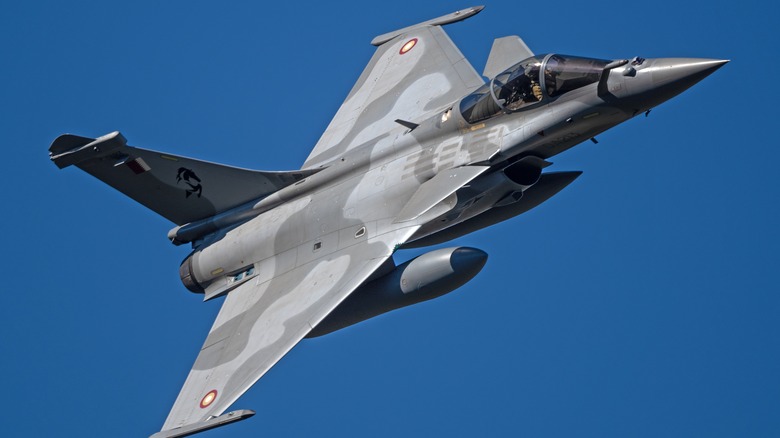
Peter R Foster IDMA/Shutterstock
When France chose not to be a part of the collaborative Eurofighter Typhoon project with some of its major allies, it left the country with two options for equipping its air force. Rather than procure third-party fighters from the U.S., France decided to design and manufacture its own aircraft in the form of the Dassault Rafale. A fourth-generation fighter with some fifth-generation technology and avionics, the Dassault Rafale stands out as a great fighter and has been adopted by military forces in nations such as Egypt and India.
Like most fourth-generation fighters, the Dassault Rafale can carry out a variety of roles, such as air supremacy and ground support, in addition to being able to act as a nuclear deterrent. The fact that it can be armed with nuclear weapons make the fighter all the more intimidating. The Dassault Rafale can also carry an armament that includes Meteor long-range air-to-air missiles, HAMMER precision-guided bombs, and an anti-ship missile — the AM39 EXOCET.
A delta wing shape and canards that are located higher up the fuselage gives the Dassault Rafale a domineering appearance. It almost looks like an arrowhead punching through the sky and when looked at head-on, it is a daunting image.
McDonnell Douglas F-15E Strike Eagle
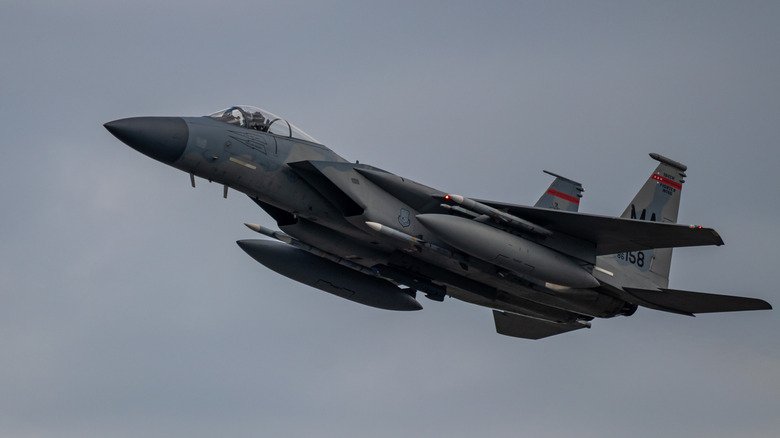
Joel Serre/Getty Images
Despite being one of the oldest fighter jets in operation with the United States Air Force, the McDonnell Douglas F-15 Eagle is still a legend of the sky. There have been several different variants of the F-15 fighter produced over the years including the Strike Eagle, which is a significant upgrade over its predecessors. It now comes with some of the most up-to-date technology when it comes to avionics and enhanced targeting systems. The fighter was first introduced in 1986 and has since flown in combat zones such as Afghanistan, Iraq, and Syria.
When it comes to its weaponry, the Strike Eagle simply looks deadly. It can carry up to eight air-to-air or air-to-surface missiles and has a 23,000-pound maximum payload. It is also one of the few U.S. aircraft that is capable of carrying nuclear weapons, such as the B61-12 nuclear gravity bomb. The fighter also has a distinctive dark grey paint job compared to lighter shades usually used for aircraft and conformal fuel tank fitted tightly to the inside of the wings, giving it an even more ominous appearance.
Boeing F/A-18E/F Super Hornet
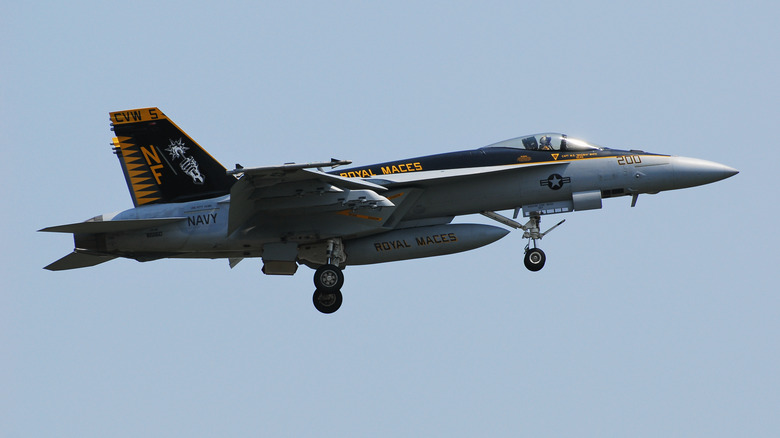
viper-zero/Shutterstock
The Boeing F/A-18E/F Super Hornet is a multi-role naval fighter that was largely based upon the earlier McDonnell Douglas F/A-18 Hornet, one of the most legendary naval aircraft ever flown. Introduced in 1999, it is an improvement over its predecessor in almost every way. It is larger, can carry and launch more powerful weapons, and can fly further without needing to refuel. It is primarily used by the United States Navy but is also operated by the Australian Air Force and the Kuwait Air Force.
Like many fighters, the Super Hornet has an angular design, intended to help make it stealthier. It is also much more dominating to look at because of its sheer size. It is about 20% larger than the original Hornet and has a maximum takeoff weight of 66,000 lbs, almost 15,000 more than the earlier aircraft. Despite all of this, it can still reach speeds of Mach 1.6.
What really makes the Super Hornet so imposing is its weaponry. It comes equipped with a M61A2 Vulcan rotary cannon and can carry a wide variety of missiles, bombs, and pods. This includes the well known AIM-9 Sidewinder and the 12-foot long AIM-120 AMRAAM .
Sukhoi Su-57
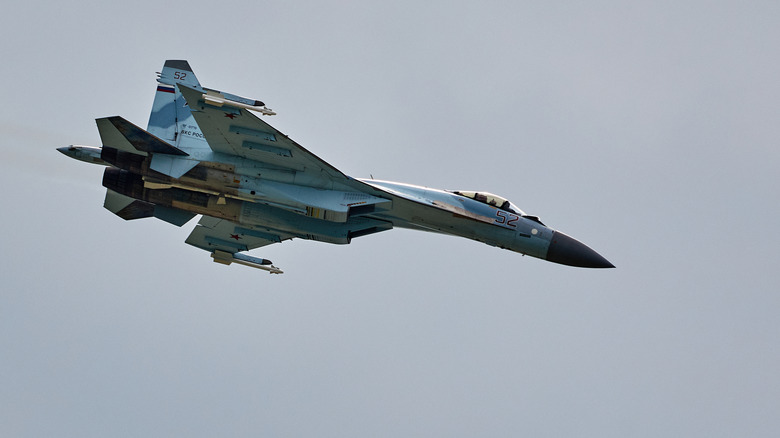
Oleg Nikishin/Getty Images
After the United States had developed the F-22 Raptor and the later Lockheed Martin F-35 Lightning II, it became important for Russia to produce its own fifth-generation fighter. The country’s response came in the form of the Sukhoi Su-57 Felon jet, a stealth multirole fighter that is meant to match the capabilities of the U.S. fifth-generation fighters to keep Russia on even footing with its old rival.
Although there’s a lot of debate about how good the Su-57 actually is, there is little doubt that its specs look impressive — at least on paper, anyway. The jet, which will eventually replace the MiG-29 and Su-27 in the Russian Aerospace Forces, is capable of flying at Mach 2 and can be armed with Kh-59 and Kh-69 cruise missiles, allowing it to fire on targets from many miles away.
Even if the Su-57 does have some technical problems and is limited in terms of numbers, that doesn’t make it any less scary. It has an unusual and menacing shape compared to other fifth-generation fighters and also produces a fearsome howl-like noise due to the configuration of their engines, which is somewhat reminiscent of the terrifying German Stuka dive bombers from World War II.
Eurofighter Typhoon
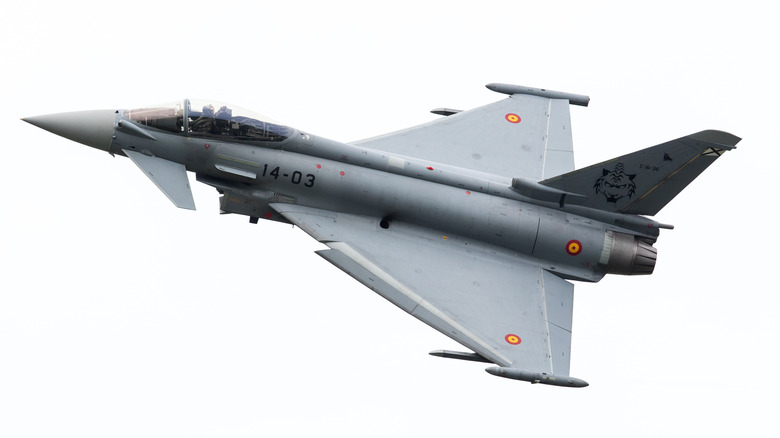
Myimages_micha/Getty Images
The Eurofighter Typhoon is the result of a joint project between Germany, Italy, Spain, and the U.K. to create a multirole fourth-generation fighter. Development started in the 1980s and the fighter was ready to make its first flight in 1994. By 2003 the fighter had entered active service, providing surveillance, air superiority, and ground strike capability. Widely regarded as one of the best fighters ever made, the Eurofighter Typhoon can reach a top speed of Mach 2.0 and a range of avionics, such as a Multifunctional Digital Information Distribution System, E-SCAN, and a cockpit heads-up display.
The Eurofighter Typhoon has a delta wing design, a purposeful decision that allows the fighter to have higher maneuverability and make quick turns in the air. This ties in with the concept of the Eurofighter Typhoon as an air superiority aircraft as it is more agile in dogfights. However, it also gives the fighter an imposing look, especially with the pointy nose and fins.
In terms of weaponry, the aircraft can be armed with everything from AIM-120 AMRAAM air-to-air missiles to Paveway precision guided bombs, as well as several different air-to-ground missiles. When fully loaded, the Eurofighter Typhoon looks like a machine of complete destruction that can take out anything in its path.
Mikoyan-Gurevich MiG-21
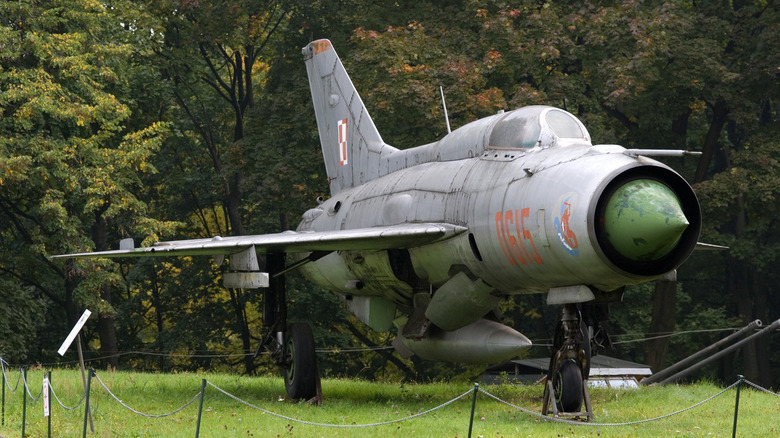
Nyiragongo/Getty Images
The MiG-21 is a supersonic fighter that is capable of flying at Mach 2 and is still in use today. Used by dozens of countries around the world during its lifetime, the MiG-21 was produced in huge numbers. In fact, more than 10,000 have been manufactured since its introduction into active service in 1959. This was just a few years after the development began on the project, which was reworked several times before the iconic final design was approved.
What makes the MiG-21 such a terrifying jet fighter is its striking appearance. It has a prominent delta wing shape as well as a unique fuselage that features a pointed nose and an inlet cone. This helped slow air down at the front of the aircraft so that the air intake worked effectively. The shock cone design was so unique it ensured the MiG-21 had a defining characteristic that helped ensure it would be instantly recognizable and terrifying.
The MiG-21 was also heavily armed, featuring up to four rocket pods and air-to-air missiles such as the K-5 Alkali and K-13 Atoll missiles, which could either be radar guided or heat-seeking. The layout of the fighter meant that these weapons were clearly on show and made the aircraft look even more fearsome as you can clearly see the carnage that it can dish out to enemies.
Lockheed Martin F-22 Raptor
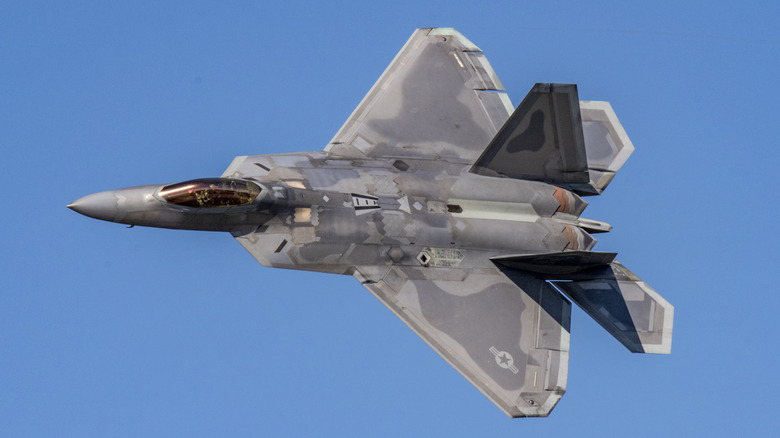
Robert Michaud/Getty Images
Initially, the Lockheed Martin F-22 Raptor was developed as a replacement for the F-15 and F-16 fighter jets but also emerged as a credible alternative to the F-117 Nighthawk. It became the first fifth-generation fighter jet and the F-22 has strengths that no other modern aircraft can match. It is primarily an air superiority fighter, using its stealth capabilities to silently engage enemy fighters and destroy them before it can be detected. However, it is also able to take part in other types of missions as well, including carrying out ground strikes or taking part in surveillance or electronic warfare.
First flown in 1997, the F-22 entered active service in 2005 and is exclusively used by the United States Air Force. It comes with a suite of avionics that allow it to target enemies from great distances and has an armament of AIM-120C/D AMRAAM missiles, AIM-9M/X Sidewinder missiles, and the precision guided GBU-39 SDB bomb. The truly terrifying thing about the F-22, though, is its shape and design. Unlike the Nighthawk, which utilized radar-absorbent materials, the F-22 relies entirely on its particular angular style and this gives it an otherworldly appearance, especially if you get a chance to see it head on.
Sukhoi Su-47
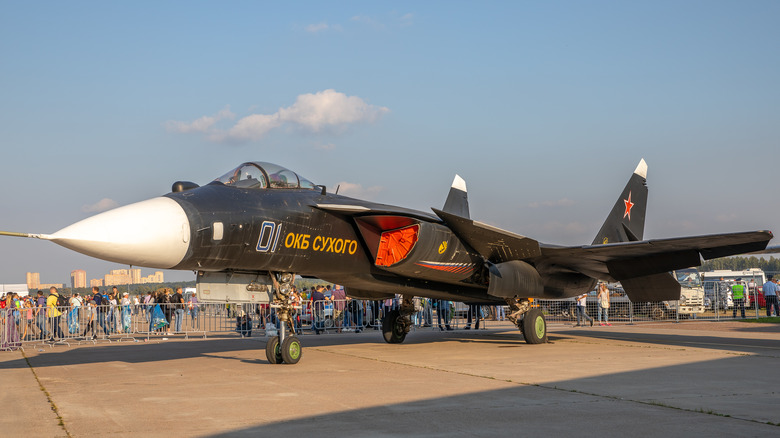
Dianov Boris/Shutterstock
Soviet Union-era aircraft more often featured unusual designs that were very different to the fighter jets developed by other nations, and the Sukhoi Su-47 is a perfect example of this. The aircraft features a tandem-triple layout, meaning that there were three sets of wings — including a set of canards and tailplanes — across the body of the fighter.
That wasn’t the only atypical design choice, however, as the Su-47 also featured forward-swept wings that essentially point in the opposite direction to most jets. This gave the Soviet aircraft a striking look, which when combined with the black paint and white nose, made it look like something a villain in an action movie would use.
Those forward-swept wings were not just for show. They allowed the Su-47 to have a high degree of maneuverability at low speeds, allowing them to make tighter turns and quickly change direction. While it was undoubtedly a fierce fighter jet, the Su-47 was never created in large numbers and was ultimately cancelled in part due to the dissolution of the Soviet Union. The development of the Su-47 can be traced back to the 1980s and it was first unveiled in the 1990s, although the Russian government eventually abandoned the unique design.
Lockheed F-117 Nighthawk
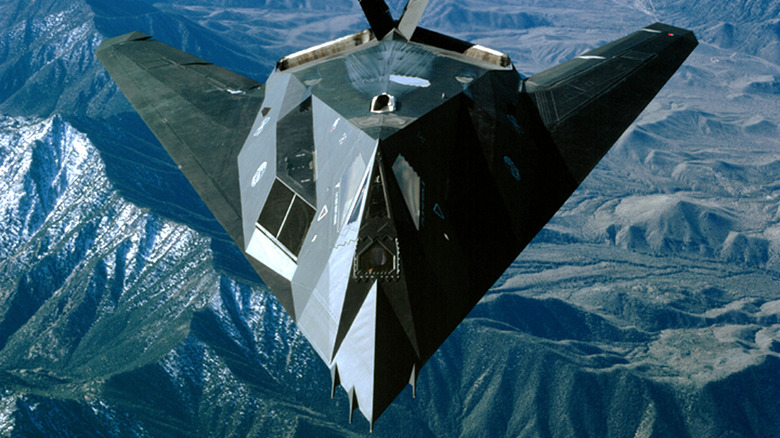
Usaf/Getty Images
The Lockheed F-117 Nighthawk was America’s first stealth jet. Of course, that just means it was invisible to radar and other forms of electronic detection, not naked to the human eye. The angular frame was an intentional attempt to deflect radar waves but also had the by-product of creating a fighter jet that was incredibly distinctive from anything else ever seen before and utterly terrifying to behold — even more so thanks to the black camouflage.
The F-117 Nighthawk was the product of years of research and development from the Lockheed Corporation. Early prototypes were created in the 1970s and it first took to the skies in 1981 as part of a top-secret project that even some high-ranking military officials were unaware of. The aircraft was created in an attempt to be able to create a stealth jet that would be able to go deep behind enemy lines and strike at ground targets without being detected, largely in response to the air defenses in use in the Soviet Union. Resembling a UFO more than a fighter jet, the F-117 Nighthawk was involved in combat in both Gulf Wars and the Kosovo conflict.